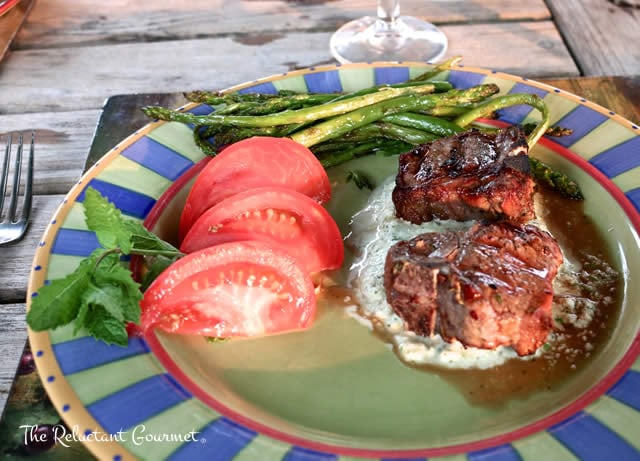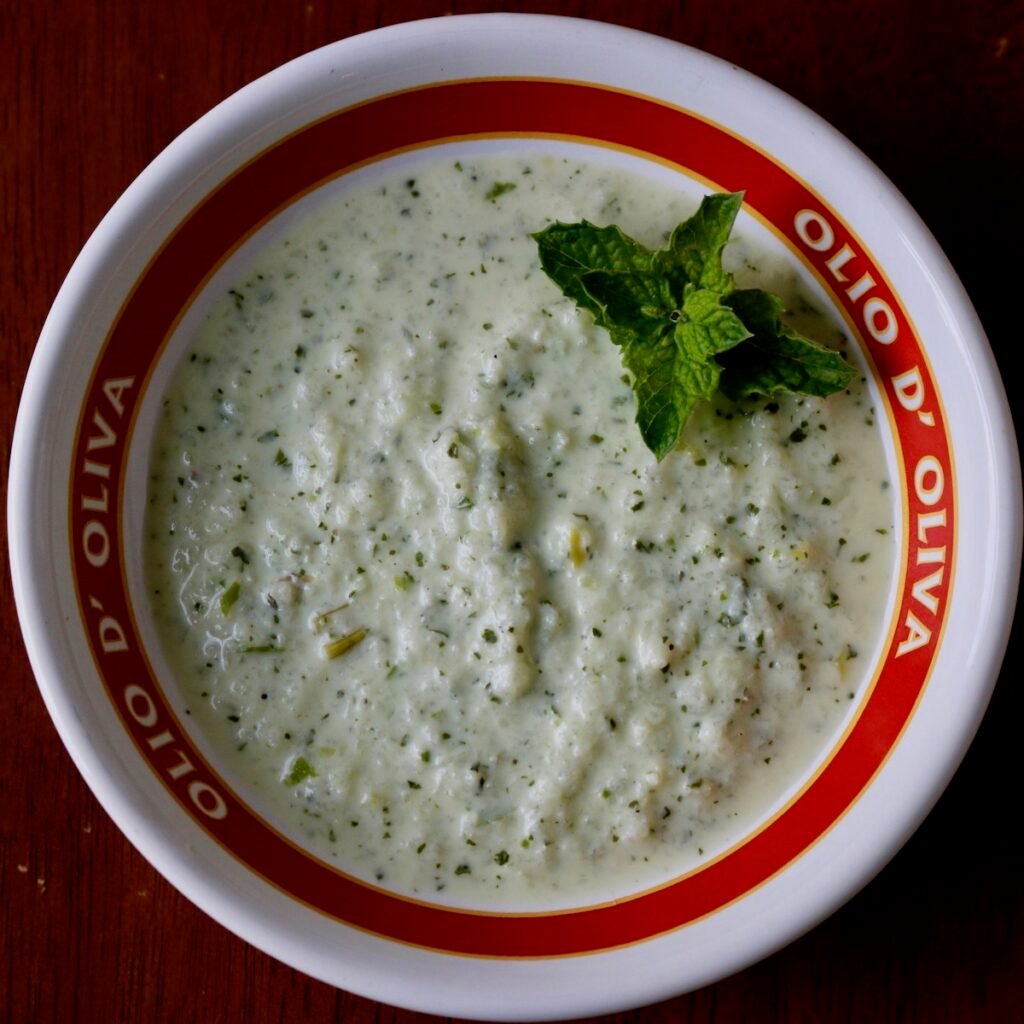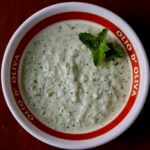A Classic Greek Sauce For Lamb, Chicken or Veggies
Last night, we grilled up some bone-in lamb loin chops and served them with this traditional Mediterranean cucumber yogurt sauce called tzatziki, and it’s incredible. I can see myself serving this with other meats and poultry or as a dip with vegetables or pita bread.
For lunch today, I heated up a corn tortilla, added a spoon of leftover orzo, a few thin slices of a leftover loin chop from last night, and topped it with some tzatziki sauce. Fantastic!
This tzatziki recipe is pureed, so no need to chop the ingredients finely. Your food processor or blender will take care of this for you. I’ve read that it is sacrilegious to use a food processor and that you should only hand-grate the ingredients.
I disagree and don’t have a problem with using tools to speed up the process as long as they don’t destroy the flavor. Saying that, if hand grating would make it taste that much better than what I experienced last night, I better give it a try.
Also, I’ve read tzatziki recipes using different ingredients, including dill rather than mint or regular yogurt instead of Greek yogurt. More important to me is using the freshest ingredients you can find.

Tzatziki sauce is a creamy and refreshing condiment originating from Greece, widely enjoyed for its tangy flavor and cooling properties. Made with a base of strained yogurt (typically Greek yogurt), cucumber, garlic, olive oil, lemon juice, and herbs, tzatziki sauce is a versatile accompaniment that complements a wide range of dishes.
The primary ingredient in tzatziki sauce is yogurt, which provides a creamy and tangy base. Greek yogurt is preferred for its thick and creamy consistency, resulting from the straining process that removes excess whey. Cucumber adds freshness and a subtle crunch to the sauce, while garlic contributes a pungent kick and depth of flavor. Olive oil adds richness and smoothness, while lemon juice brightens the sauce’s acidic tang.
The word “tzatziki” (τζατζίκι) comes from the Greek language. Its exact meaning can vary slightly depending on regional dialects, but it generally refers to a type of sauce or dip made primarily from yogurt, cucumber, garlic, and herbs. The word itself doesn’t have a direct translation in English, but it is often described as a “yogurt and cucumber sauce” or “cucumber yogurt dip.”
The origins of the word “tzatziki” are not entirely clear, but it is believed to have Turkish roots. In Turkish cuisine, there is a similar yogurt-based sauce called “cacık,” which shares many similarities with tzatziki. It’s possible that the word “tzatziki” was derived from a Turkish or Middle Eastern term and then adapted into Greek culinary vocabulary.
Herbs such as fresh dill, mint, or parsley are commonly added to tzatziki sauce, providing additional layers of flavor and freshness. Some variations may include ingredients like grated onion, vinegar, or even a pinch of salt and pepper for seasoning.
Tzatziki sauce is incredibly versatile and can be used in various ways. It is a classic accompaniment to grilled meats such as souvlaki (skewered meat), gyros (rotisserie meat), or kebabs, adding moisture and flavor to the dish. It can also be served as a dip for pita bread, vegetables, or chips or a spread for sandwiches, wraps, or burgers. Its cool and creamy texture makes it a refreshing addition to mezze platters or as a topping for salads and grain bowls.
Tzatziki sauce is beloved for its vibrant flavor, creamy texture, and versatility. It is a staple in Greek cuisine and a favorite condiment worldwide.
Tzatziki sauce has a long and rich history, originating from Greece and dating back centuries. While the exact origins of tzatziki are not well-documented, it is believed to have ancient roots in Greek and Middle Eastern cuisine.
One theory suggests that tzatziki sauce may have originated in ancient Persia, where a similar yogurt-based sauce known as “mast-o-khiar” was consumed. As trade and cultural exchange occurred between Persia and Greece, it is thought that the recipe for mast-o-khiar was introduced to Greece and adapted to local tastes and ingredients, eventually evolving into what is now known as tzatziki.
Tzatziki sauce likely became popular in Greece during the Ottoman period, when Turkish influences brought yogurt-based dishes to the region. The combination of yogurt, cucumber, garlic, and herbs provided a refreshing and cooling accompaniment to Ottoman cuisine’s rich and spicy flavors.
Over time, tzatziki sauce became a staple in Greek cuisine, where it is enjoyed as a condiment, dip, or sauce for various dishes. Its versatility and refreshing flavor made it well-suited for accompanying grilled meats, gyros, souvlaki, and other traditional Greek dishes. Tzatziki sauce also became a popular component of mezze platters, serving alongside other dips, salads, and appetizers.
Today, tzatziki sauce is celebrated in Greece and worldwide. It has become a beloved condiment and dip in Mediterranean and Middle Eastern cuisine. Its rich history and enduring popularity reflect its cultural and culinary icon status.
Tzatziki is a beloved and iconic condiment in Greece, commonly served with grilled meats, gyros, souvlaki, and other dishes. Its tangy flavor and refreshing texture make it a popular accompaniment to Mediterranean cuisine. Whether used as a dip for pita bread and vegetables or as a sauce for meat dishes, tzatziki adds a deliciously creamy and herbaceous element to meals.
Tzatziki Sauce For Lamb
Ingredients
- 2 scallions roughly chopped
- 1 garlic clove roughly chopped
- 1 medium cucumber peeled, seeded & chopped (about 1 cup)
- ½ cup plain Greek yogurt
- 3 tablespoons fresh mint leaves
- 1 tablespoon olive oil extra virgin
- 1 teaspoon lemon zest chopped
- 1 tablespoon fresh lemon juice
- salt & pepper to taste
Instructions
- Add the scallions, garlic, cucumber, yogurt, mint, olive oil, lemon zest, lemon juice and a little salt and pepper to a food processor or blender and puree using the pulse button to start and puree button to make smooth.
- Taste and adjust seasoning with salt and pepper if needed.
- Transfer to a container until ready to use. You can make this earlier in the day and store into the refrigerator until ready to use.








